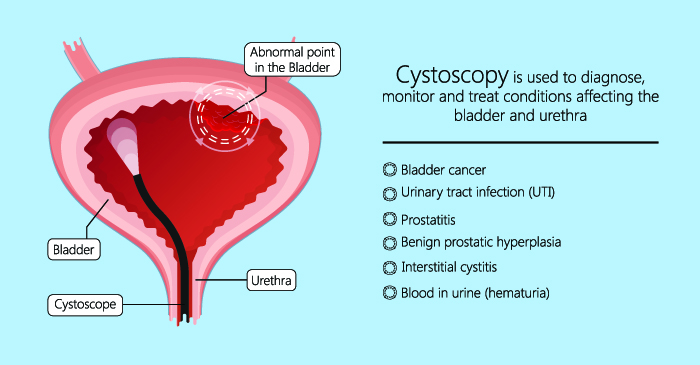Cystoscopy Surgery in Tardeo, Mumbai
Your urinary bladder stores urine until it flows out of your body through the urethra. Sometimes you might observe blood in your urine or might frequently contract urinary tract infections. This might be a result of the narrowing of the urethra or an infection in the bladder. This can be diagnosed by Cystoscopy.

What is Cystoscopy?
Cystoscopy is a procedure to diagnose what ails the lining of your bladder and urethra. Cystoscopy is an outpatient test that can be done at a doctor’s clinic or at a hospital. The cystoscope is a pencil-sized, lighted hollow tube with a camera. It is inserted into your urethra and moves into the bladder. Cystoscopy helps a urologist diagnose and sometimes treat urinary tract infections.
You can avail of this procedure at any of the urology hospitals in Mumbai or you can search online for a urology doctor near me.
What are the types of Cystoscopy?
- Rigid Cystoscope – This cystoscope doesn’t bend and is used to perform biopsies or removal of tumors.
- Flexible Cystoscope – Since it is flexible, it is used to examine the bladder and the urethra.
What are the symptoms that lead to a Cystoscopy?
If you observe any of the following signs and symptoms, then you may need Cystoscopy:
- Blood in the urine (hematuria)
- Pain while urinating (dysuria)
- Inability to control urination
- Frequent urinary tract infections
- Urinary bladder stones
Why is Cystoscopy needed?
There can be various reasons such as:
- Urinary bladder stones
- Enlarged prostate gland
- Bladder inflammation
- Urethral cancer
- Problem with the ureter
- Narrowing of the urethra
When do you need to see a doctor?
If you observe constant issues while urinating or suffer from frequent urinary tract infections, you must consult a urologist about the same. The doctor will collect urine samples to diagnose bladder conditions.
You can request an appointment at Apollo Spectra Hospitals, Tardeo, Mumbai.
Call 1860 500 2244 to book an appointment.
How is Cystoscopy done?
The doctor will apply numbing jelly on your urethra and push a cystoscope in the urethra through your penis. The cystoscope has a camera over its lens to magnify the image of the bladder and the urethra and display them on a screen. Your bladder will be filled with a sterile solution so that it stretches. It is thus easier to examine the entire bladder wall. The doctor will collect some tissue samples by cutting them with the help of a cystoscope. At the end of the procedure, you will have a strong urge to urinate due to the sterile solution inside your bladder.
What are the benefits of Cystoscopy?
Cystoscopy is a useful procedure for treating very small bladder tumors. It can detect narrowing of the urethra, thus indicating enlarged prostate. If you have bladder cancer, bladder stone or bladder inflammation, it can be detected through Cystoscopy.
What are the risks?
Although Cystoscopy is a safe diagnostic procedure, some risks are associated with it like:
- Swelling in the urethra (urethritis)
- Fever, nausea, chills and lower back pain
- Foul smell in urine
- Blood in urine
- Clotting in bladder leading to blockage
- Rupture of the bladder wall
- Change in the natural balance of sodium in the body
What happens after Cystoscopy?
After cystoscopy, you must consume lots of fluids to flush out the bladder, and avoid alcohol consumption. Your doctor might suggest pain killers. Keep a warm cloth over your penis to reduce the pain or take a bath in warm water. Your doctor might prescribe antibiotics to reduce the chances of infection.
Conclusion
Cystoscopy is a low-risk procedure to diagnose urinary tract problems. For some patients, cystoscopy can be uncomfortable but it isn’t painful. You need to wait for the biopsy results to know the condition of your bladder and the urethra.
Cystoscopy is not a painful procedure but you might sometimes feel pain during urination afterwards due to swelling in the urethra.
You must avoid strenuous activities after Cystoscopy like jogging, weight lifting or aerobics. You can return to work after a couple of days.
You might observe a small amount of blood in your urine after a couple of days. If the bleeding is prolonged, you must talk to your doctor.
After Cystoscopy, you might have problems while urinating so you can use a catheter to drain the bladder.
Usually, as a result of Cystoscopy, you might observe blood clots that might get released through the urine.
Symptoms
Our Top Specialities
NOTICE BOARD
CONTACT US
CONTACT US
 Book Appointment
Book Appointment


.svg)
.svg)
.svg)
.svg)








